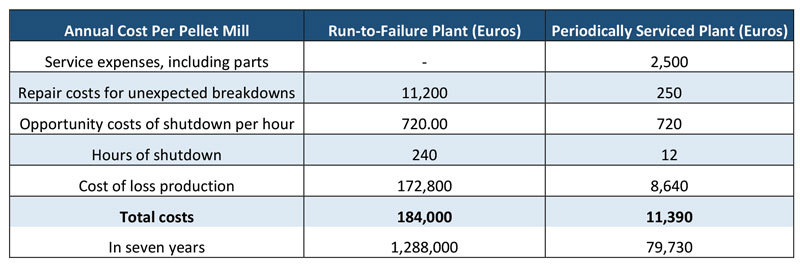Run-to-Failure vs. Periodical Service







September 30, 2019
BY Holger Streetz
There are diverging opinions when it comes to original equipment manufacturer (OEM) service. The two extremes for operating pelleting equipment are spending money on OEM post-commissioning service and regular maintenance by third parties, or running the equipment to failure. This column compares both scenarios based on real-world examples.
Any fully commissioned, operating pellet plant needs regular maintenance and service. Most companies follow a shutdown procedure to periodically replace wear parts, deal with small or major repairs of equipment and inspect weak spots. Often, the plant’s own staff is accompanied by third parties in order to get as many tasks done as possible within the available time. This does not protect from premature failure of equipment, but it helps predict and schedule a planned replacement, rather than sudden and expensive shutdown. However, there are still plants that operate a run-to-failure approach. The reasons reach from ignorance to financial notch.
Post-commissioning service, depending on the brand and pellet mill type, includes periodical change of seals, gear oil, filters and other wear parts. Additionally, the downtime is used to inspect the condition of main bearings, the alignment of shafts and the condition of other critical components for unusual wear and correct alignment.
For example, the total repair costs for having three pellet mills running totalizes to some 105,000 euros ($116,500) plus another 130,000 euros of investment bottleneck to get back to an optimum operation with scheduled downtimes. The cost comparison for serviced versus run-to-failure operation is based on the assumption that each pellet mill produces four tons per hour at a sales price of 180 ($198) euros per ton of wood pellets (for the residential heating market). The 240 hours of shutdown are a soft assumption, taking into account that some spare parts take weeks for delivery. The comparison shows that not servicing a pellet mill for years leads to four times higher repair costs. The costs of loss production reach factor 20 and account for the lion’s share of total costs.
The table compares a run-to-failure operated wood pellet plant versus a periodically serviced wood pellet plant. These figures show the annual cost per pellet mill and do not include the one pellet mill down for seven years, but assumes the numbers per pellet mill.
In seven years, the run-to-failure operated plant is 1.2 million euros short compared to an annually serviced plant, not taking into account that one press is not working at all. With only two of three mills working for seven years, the loss in revenue adds up to some 5 million-plus euros. This example shows that even in times during which funds are low, it’s a bad choice to save on service and maintenance, because it destroys the foundation of production, and thus, turnover. Not only does the run-to-failure approach lack inspections for wear parts that are not easily accessible, but it also increases the risk of sudden breakdowns with long waits for spare parts.
Author: Holger Streetz
Director of Business Development, Bathan AG
h.streetz@bathan.ch
Advertisement
Advertisement
Upcoming Events





